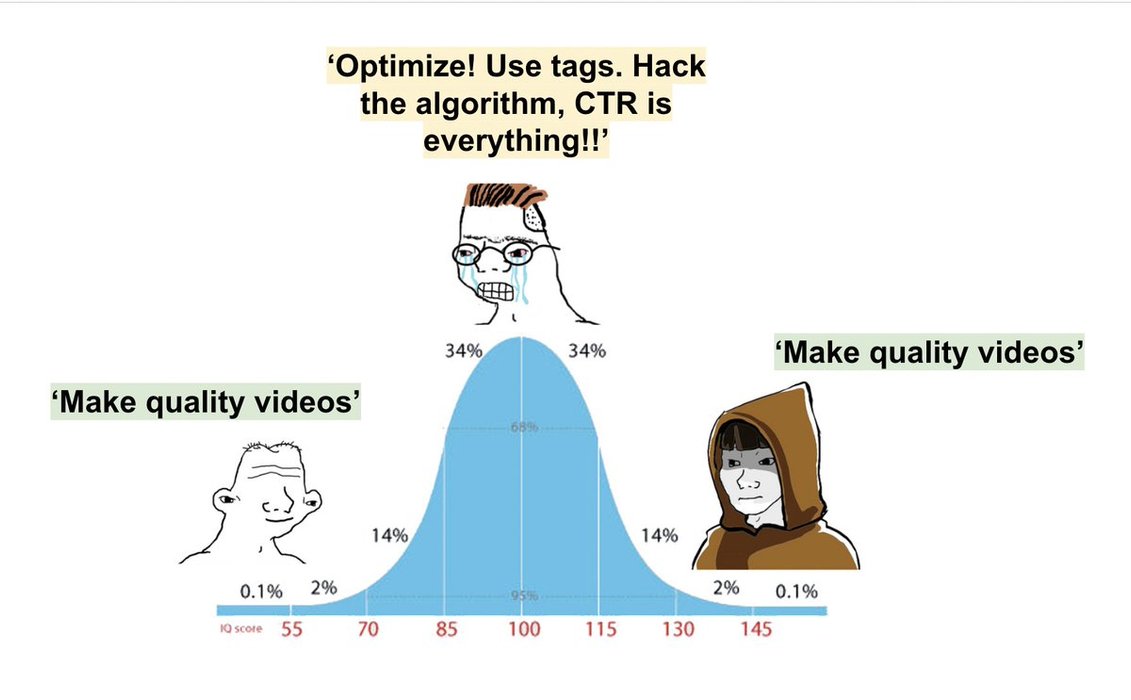
''Just make high quality videos bro'' It's hard to argue with this advice when it comes to growing a YouTube channel. However, It feels like 90% of creators misinterpret what ''quality'' is. Here's how to actually make better videos and give the algorithm (audience) what it wants: First of all, what do I mean by creators misinterpret quality? I find when I say ''make quality videos'' people's mind usually goes to things like: - Camera resolution (shooting in 4k) - Getting perfect video lighting - Using fancy transitions/montages - Incorporating animation or other high effort edits. This is production value. It's part of what makes a great video, but it's often overvalued. I'm not saying it doesn't matter, and in certain niches and for certain audiences it's crucial. It's just not the only way to make higher quality videos. Here are 4 other ways to bring quality to your content: 1. Bringing quality to idea selection People may have heard me use statements like ''the idea is everything'' and while hyperbolic, there is a huge amount of truth to this. Your idea is what sets the bar for how far a video can go. A weak idea on something your audience find un-interesting will perform badly regardless of other ways you bring ''quality''. I really like this quote from legendary entrepreneur Paul Graham: ''What might seem to be merely the initial step — deciding what to work on — is in a sense the key to the whole game'' So how do we bring extra quality to idea selection? - Allocate more ''thinking time'' to ideas - Allocate more research time to ideas - Truly look for something unique and innovative - Brainstorm a greater volume of ideas - Have an elimination criteria for your ideas Doing this doesn't guarantee you'll come up with quality ideas, but increases the probability. I use my 100-10-1 framework. I will typically brainstorm 100 ideas, whittle them down to my best 10, and make the one I am most confident in. 2. Carefully plan your story The extent to which you use storytelling in your video depends on your niche and content format. However, everyone can benefit from some form of planning ahead of time. For some, that might be intricately scripting every word and weaving in a hero's journey story structure. For others it may just be some basic storyboarding or structuring to make sure the video isn't just waffle. There are exceptions, but generally I don't want my clients to just ''wing it''. Casey Neistat can do that and still make an incredible story, most creators can't. 3. Sweat the little production details Ok so let's say you've got a quality idea and you've spent more time planning the story. What next? Make sure you hold yourself (or your team) to the highest standards when it comes to the on-day production. This lends itself to production-value but it is so much more than just having the best camera. Some random ideas: - Choosing the best location for the shoot - Planning for a day when weather suits - Spending extra time to test audio and footage - Spending time on casting people for the video - Buying and testing props ahead of time Sometimes it's the smallest details that can make or break a shoot. Maybe you're going to have a scene where you put a fish bowl on a table, the fish bowl is blue, so you look for a light brown table to bring the colors out. Tiny details that most miss. 4. Bringing tangible ''effort'' to your videos I want my viewers to be able to tangibly feel the effort we have put into a video. Show the viewer that you have put a ton of thought and time into delivering this 10 minute video for them. How do you do this? Some quick ideas: - Showing passing of time: If you spent a lot of time on your video, find ways to show this off. Maybe it's time-lapses, maybe it's just documenting the days as they pass. - Big numbers: Reading 100 books on productivity to research your video. Buying every budget monitor and reviewing each one to find the best. - Big budgets: Making it clear you invested a lot of $ to make this video happen. Obviously not applicable for most, but it's still a way people message ''effort'' to their audience. Although sometimes lazily used to cover up for lack of effort in other areas, but that's a story for another day. - Showing persistence: Not giving up easily and trying multiple times to beat the challenge or break the record. You can call a lot of this stuff ''costly-signalling'' basically showing the viewer this video ''cost'' you a lot, and that doesn't have to be money. --- These are just 4 ideas that have helped me. Quality is subjective and it's hard to build an exact broadly-applicable science around... To me it's just about putting in effort to hit viewer satisfaction - truly caring about the audience and giving them a worthwhile experience. Not trying to just tick some box or ''hack'' the algorithm. So next time you hear this ''make better videos'' advice, don't just think ''I need to start shooting in 8k''. Hope this was helpful. I'll be giving away a free consultation (worth $1,000+) to one person who likes and retweets. Now go make some quality videos! (P.s. I asked one of the world's biggest creators for advice for tomorrow's newsletter. Join 15,000 creators. Link in bio)


